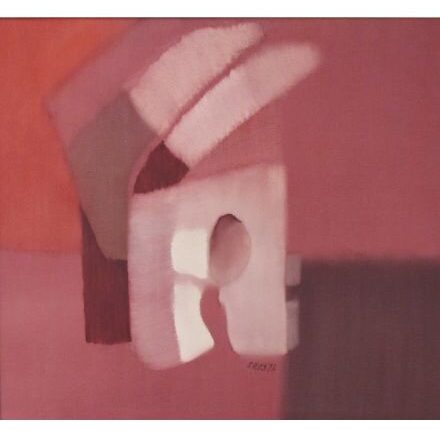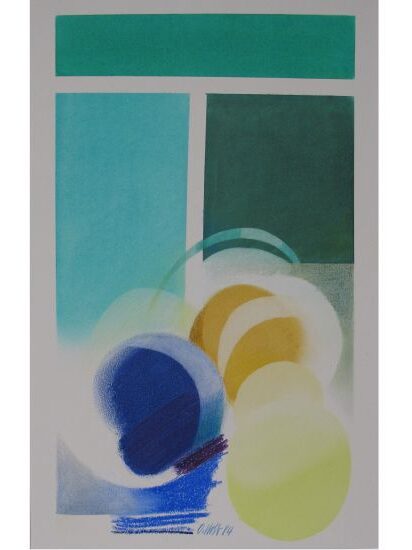Kolb, Oskar
Kolb, Oskar
Painter, art teacher
Born: 14.11.1923 in Ratzenried near Wangen im Allgäu
died: 24.09.1998 in Wiesbaden
After training as a painter with O. Briegel in Wangen and completing his military service, Kolb attended the master school for painters in Reutlingen. In 1945 he married Gerdi Lieglein, a native of Wiesbaden, but it was not until 1949 that the couple finally settled in Wiesbaden. After attending evening classes at the Werkkunstschule Wiesbaden, Kolb first became Vincent Weber's assistant, then head of the painting department and finally a lecturer at the Fachhochschule Wiesbaden(RheinMain University of AppliedSciences), into which the Werkkunstschule had merged in 1971. He taught herSciences), into which the Werkkunstschule had merged in 1971. He taught here as a professor in the design department until 1980. From 1981, he was head of the art appreciation department at the Wiesbaden School of Fine Arts (wfk) until the 1990s.
Kolb joined the artists' group 50 in 1954. In 1957, he worked with Vincent Weber on the stained glass windows of the Friedrich-List-Schule in Wiesbaden. In 1960, he created a mosaic in the entrance area of the Oranienschule gymnasium. He created a façade design for the Adalbert Stifter School, the symbolization of the Pythagorean theorem (1963), and in 1969 the painterly design of a learning and play wall in the Comenius School, which is still preserved. In the following years, he was the winner of numerous competitions for environmental design and received public commissions until the 1980s. In addition, his work was regularly presented in numerous solo, group and traveling exhibitions in Germany and abroad. As early as 1957, he took part in the "Biennale 57" in Paris on the theme of "Jeune Peinture - Jeune Sculpture" at the Palais de Marsan, Louvre. Kolb left behind an extensive and multifaceted artistic oeuvre. In addition to the aforementioned art on buildings, drawings, watercolors, gouaches, oil paintings and poems have survived. His painting career began in the second half of the 1940s with still lifes, landscapes and interiors, which he increasingly abstracted until the early 1950s. This was followed by a constructive phase and then an informal, lyrical-abstract phase at the end of the 1950s. He was particularly interested in the art theories of Adolf Hölzel and the Bauhaus masters, but also in contemporary art movements. Alongside form, color became increasingly important. As a result, he created large-format pictorial compositions with differentiated color tones, sometimes darkly meditative, sometimes intensely luminous in character. (see Groos)
For decades, Kolb had a significant influence on Wiesbaden's art scene and was the first artist in Wiesbaden to be awarded the Cultural Prize of the State Capital of Wiesbaden in 1984. His works are mainly in private hands, but also in public ownership. Between 1978 and 2008, for example, the Wiesbaden Cultural Office acquired twelve works for the Artothek Wiesbaden. After Kolb's death, a major retrospective was held at the Nassauischer Kunstverein Wiesbaden e. V. in December 1999. In 2008, the 10th year of his death, the Artothek also presented a selection of works from the years 1947 to 1998 in his honor. The last exhibition for the time being, "Klang des Geistes", a presentation of Kolb's 50-year creative period, was dedicated to him in 2013 by the Wiesbadener Freie Kunstschule (wfk). The artist's estate is being administered by his heirs. His grave is located in Wiesbaden's Südfriedhof cemetery.
Literature
- Gessinger, Matthias; Kolb, Oskar
Drawing made easy, Munich 1981.
- Groos, Dietrich
Thoughts on the painterly work. In: Kolb-Lieglein, Gerdi (ed.): Oskar Kolb. Retrospective 1946 - 1998, exhibition at the Nassauischer Kunstverein e. V. Wiesbaden, 12.12.1999 - 6.2.2000, Wiesbaden 1999. (p. 6 f.)
- Wiesbadener Freie Kunstschule, wfk [Hrsg.]
Sound of the spirit. The Wiesbaden School of Fine Arts presents the 50-year creative period of Oskar Kolb, Wiesbaden 2013.

